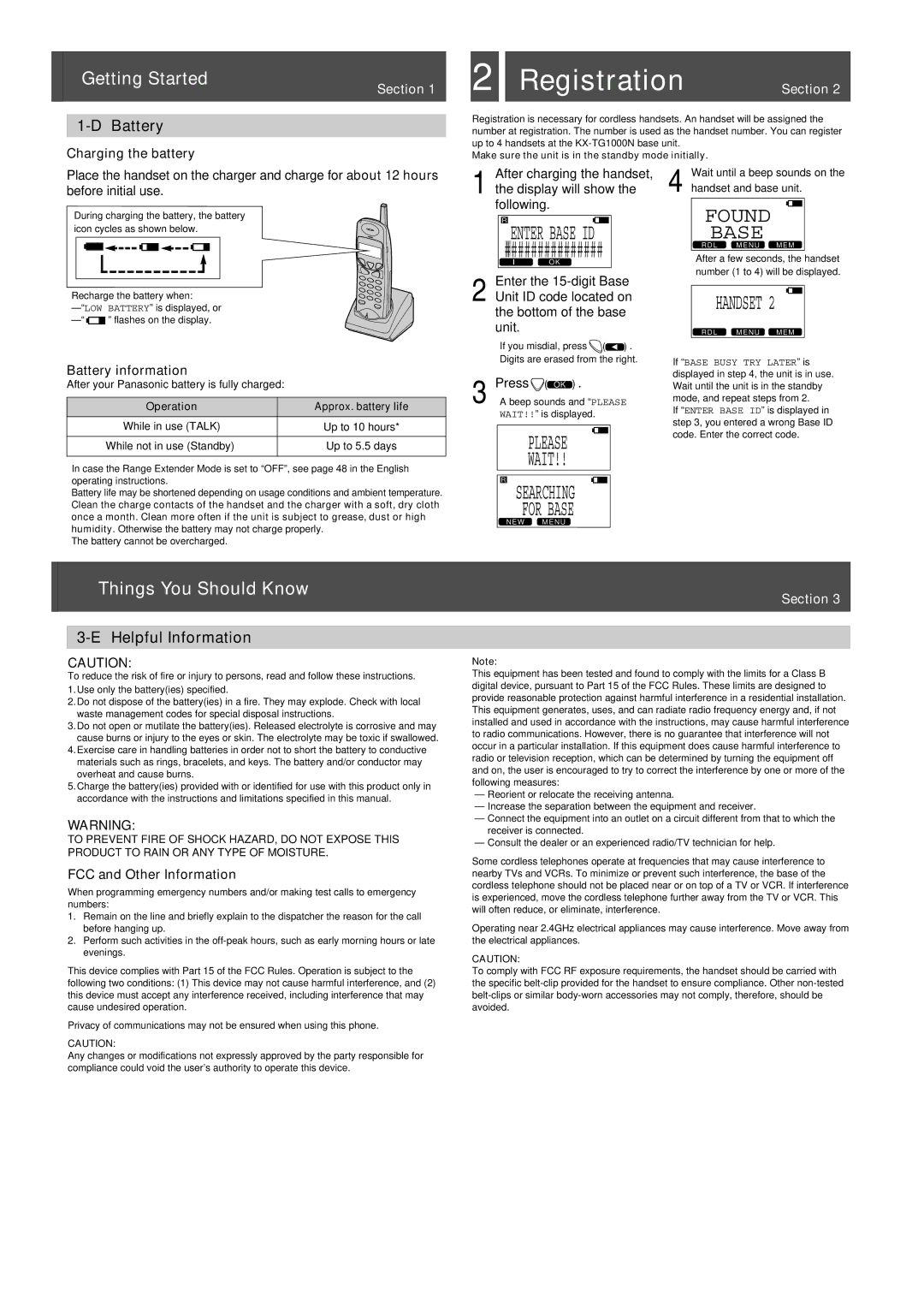
Getting Started
Charging the battery
Section 1
2 Registration | Section 2 |
Registration is necessary for cordless handsets. An handset will be assigned the number at registration. The number is used as the handset number. You can register up to 4 handsets at the
Make sure the unit is in the standby mode initially.
Place the handset on the charger and charge for about 12 hours before initial use.
During charging the battery, the battery icon cycles as shown below.
•Recharge the battery when: | |
” flashes on the display. | |
Battery information
After your Panasonic battery is fully charged:
Operation | Approx. battery life |
|
|
While in use (TALK) | Up to 10 hours* |
|
|
While not in use (Standby) | Up to 5.5 days |
|
|
∗In case the Range Extender Mode is set to “OFF”, see page 48 in the English operating instructions.
After charging the handset,
1 the display will show the following.
R
ENTER BASE ID
###############
IO K
Enter the
2 Unit ID code located on the bottom of the base unit.
•If you misdial, press ![]() (
(![]() ) . Digits are erased from the right.
) . Digits are erased from the right.
3 Press• ![]() ( OK ) .
( OK ) .
A beep sounds and “PLEASE
WAIT!!” is displayed.
PLEASE
WAIT!!
R
Wait until a beep sounds on the
4 handset and base unit.
FOUND
BASE
R D L M E N U M E M
•After a few seconds, the handset number (1 to 4) will be displayed.
HANDSET 2
R D L M E N U M E M
•If “BASE BUSY TRY LATER” is displayed in step 4, the unit is in use. Wait until the unit is in the standby mode, and repeat steps from 2.
•If “ENTER BASE ID” is displayed in step 3, you entered a wrong Base ID code. Enter the correct code.
•Battery life may be shortened depending on usage conditions and ambient temperature.
•Clean the charge contacts of the handset and the charger with a soft, dry cloth once a month. Clean more often if the unit is subject to grease, dust or high humidity. Otherwise the battery may not charge properly.
•The battery cannot be overcharged.
Things You Should Know
3-E Helpful Information
CAUTION:
To reduce the risk of fire or injury to persons, read and follow these instructions.
1.Use only the battery(ies) specified.
2.Do not dispose of the battery(ies) in a fire. They may explode. Check with local waste management codes for special disposal instructions.
3.Do not open or mutilate the battery(ies). Released electrolyte is corrosive and may cause burns or injury to the eyes or skin. The electrolyte may be toxic if swallowed.
4.Exercise care in handling batteries in order not to short the battery to conductive materials such as rings, bracelets, and keys. The battery and/or conductor may overheat and cause burns.
5.Charge the battery(ies) provided with or identified for use with this product only in accordance with the instructions and limitations specified in this manual.
WARNING:
TO PREVENT FIRE OF SHOCK HAZARD, DO NOT EXPOSE THIS PRODUCT TO RAIN OR ANY TYPE OF MOISTURE.
FCC and Other Information
When programming emergency numbers and/or making test calls to emergency numbers:
1.Remain on the line and briefly explain to the dispatcher the reason for the call before hanging up.
2.Perform such activities in the
This device complies with Part 15 of the FCC Rules. Operation is subject to the following two conditions: (1) This device may not cause harmful interference, and (2) this device must accept any interference received, including interference that may cause undesired operation.
Privacy of communications may not be ensured when using this phone.
CAUTION:
Any changes or modifications not expressly approved by the party responsible for compliance could void the user’s authority to operate this device.
SEARCHING
FOR BASE
N E W M E N U
Section 3
Note:
This equipment has been tested and found to comply with the limits for a Class B digital device, pursuant to Part 15 of the FCC Rules. These limits are designed to provide reasonable protection against harmful interference in a residential installation. This equipment generates, uses, and can radiate radio frequency energy and, if not installed and used in accordance with the instructions, may cause harmful interference to radio communications. However, there is no guarantee that interference will not occur in a particular installation. If this equipment does cause harmful interference to radio or television reception, which can be determined by turning the equipment off and on, the user is encouraged to try to correct the interference by one or more of the following measures:
—Reorient or relocate the receiving antenna.
—Increase the separation between the equipment and receiver.
—Connect the equipment into an outlet on a circuit different from that to which the receiver is connected.
—Consult the dealer or an experienced radio/TV technician for help.
Some cordless telephones operate at frequencies that may cause interference to nearby TVs and VCRs. To minimize or prevent such interference, the base of the cordless telephone should not be placed near or on top of a TV or VCR. If interference is experienced, move the cordless telephone further away from the TV or VCR. This will often reduce, or eliminate, interference.
Operating near 2.4GHz electrical appliances may cause interference. Move away from the electrical appliances.
CAUTION:
To comply with FCC RF exposure requirements, the handset should be carried with the specific
